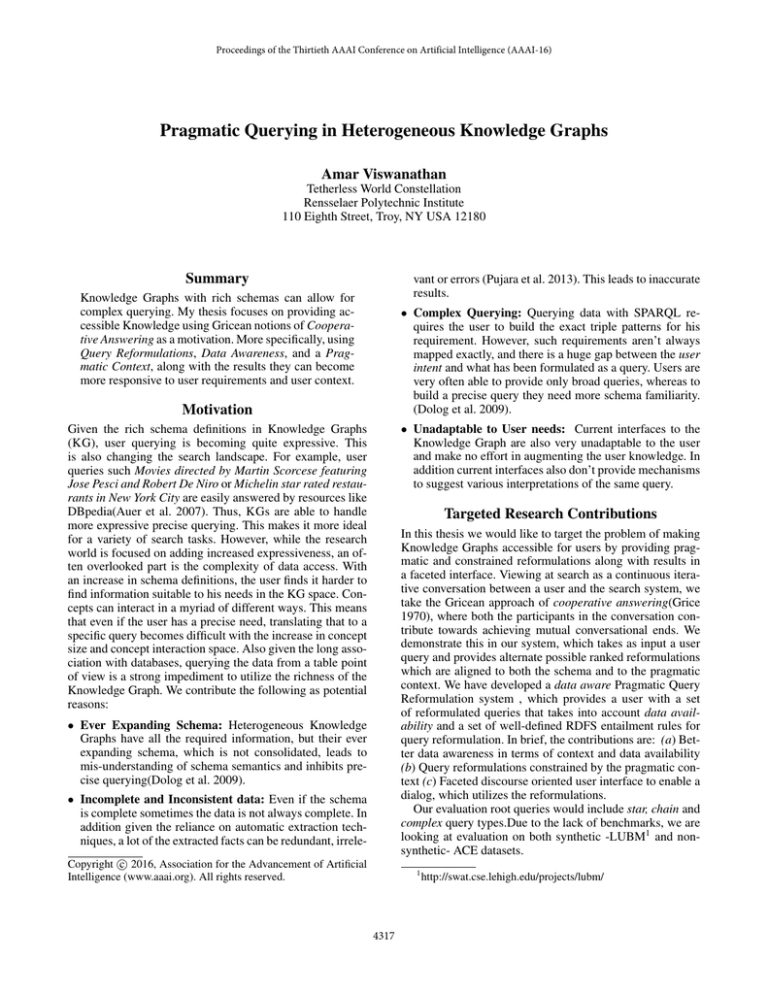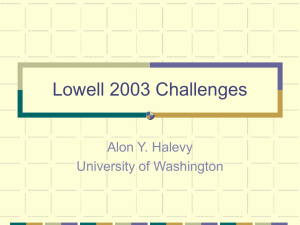
Proceedings of the Thirtieth AAAI Conference on Artificial Intelligence (AAAI-16)
Pragmatic Querying in Heterogeneous Knowledge Graphs
Amar Viswanathan
Tetherless World Constellation
Rensselaer Polytechnic Institute
110 Eighth Street, Troy, NY USA 12180
Summary
vant or errors (Pujara et al. 2013). This leads to inaccurate
results.
Knowledge Graphs with rich schemas can allow for
complex querying. My thesis focuses on providing accessible Knowledge using Gricean notions of Cooperative Answering as a motivation. More specifically, using
Query Reformulations, Data Awareness, and a Pragmatic Context, along with the results they can become
more responsive to user requirements and user context.
• Complex Querying: Querying data with SPARQL requires the user to build the exact triple patterns for his
requirement. However, such requirements aren’t always
mapped exactly, and there is a huge gap between the user
intent and what has been formulated as a query. Users are
very often able to provide only broad queries, whereas to
build a precise query they need more schema familiarity.
(Dolog et al. 2009).
Motivation
• Unadaptable to User needs: Current interfaces to the
Knowledge Graph are also very unadaptable to the user
and make no effort in augmenting the user knowledge. In
addition current interfaces also don’t provide mechanisms
to suggest various interpretations of the same query.
Given the rich schema definitions in Knowledge Graphs
(KG), user querying is becoming quite expressive. This
is also changing the search landscape. For example, user
queries such Movies directed by Martin Scorcese featuring
Jose Pesci and Robert De Niro or Michelin star rated restaurants in New York City are easily answered by resources like
DBpedia(Auer et al. 2007). Thus, KGs are able to handle
more expressive precise querying. This makes it more ideal
for a variety of search tasks. However, while the research
world is focused on adding increased expressiveness, an often overlooked part is the complexity of data access. With
an increase in schema definitions, the user finds it harder to
find information suitable to his needs in the KG space. Concepts can interact in a myriad of different ways. This means
that even if the user has a precise need, translating that to a
specific query becomes difficult with the increase in concept
size and concept interaction space. Also given the long association with databases, querying the data from a table point
of view is a strong impediment to utilize the richness of the
Knowledge Graph. We contribute the following as potential
reasons:
Targeted Research Contributions
In this thesis we would like to target the problem of making
Knowledge Graphs accessible for users by providing pragmatic and constrained reformulations along with results in
a faceted interface. Viewing at search as a continuous iterative conversation between a user and the search system, we
take the Gricean approach of cooperative answering(Grice
1970), where both the participants in the conversation contribute towards achieving mutual conversational ends. We
demonstrate this in our system, which takes as input a user
query and provides alternate possible ranked reformulations
which are aligned to both the schema and to the pragmatic
context. We have developed a data aware Pragmatic Query
Reformulation system , which provides a user with a set
of reformulated queries that takes into account data availability and a set of well-defined RDFS entailment rules for
query reformulation. In brief, the contributions are: (a) Better data awareness in terms of context and data availability
(b) Query reformulations constrained by the pragmatic context (c) Faceted discourse oriented user interface to enable a
dialog, which utilizes the reformulations.
Our evaluation root queries would include star, chain and
complex query types.Due to the lack of benchmarks, we are
looking at evaluation on both synthetic -LUBM1 and nonsynthetic- ACE datasets.
• Ever Expanding Schema: Heterogeneous Knowledge
Graphs have all the required information, but their ever
expanding schema, which is not consolidated, leads to
mis-understanding of schema semantics and inhibits precise querying(Dolog et al. 2009).
• Incomplete and Inconsistent data: Even if the schema
is complete sometimes the data is not always complete. In
addition given the reliance on automatic extraction techniques, a lot of the extracted facts can be redundant, irrelec 2016, Association for the Advancement of Artificial
Copyright Intelligence (www.aaai.org). All rights reserved.
1
4317
http://swat.cse.lehigh.edu/projects/lubm/
ACE’05 3 schema. In q1 , the given query is matched against
{ENTITY,ROLE,EVENT} from the schema. The Schema
built from the documents has a total of 132 classes and 233
Logical axioms, along with 37 Object Properties and 10
Data Properties. In addition to these results we have built
a discourse enabled faceted user interface that eases the interaction with the KG.
Background and State-of-the-art
The foundations of my approach lie in the application of
Grice’s principles(Grice 1970). Grice proposed that, talk exchanges do not normally consist of a succession of disconnected remarks, but they are, to some degree, cooperative
efforts and the participants recognize in them, a common
set of goals. To be able to achieve this in the current context a system should be able to talk to the user and provide
contextually relevant information or additional similar relevant queries. So we rely on Query Relaxations and Query
Reformulations, which are a part of Cooperative Answering.
Generally Reformulations for RDF graphs are focused on
Relaxations or Generalizations(Hurtado, Poulovassilis, and
Wood 2008) aimed at pushing more relevant content to the
users. Such relaxations are either deductive relaxations or
use RDFS semantics i.e. type hierarchy or property hierarchy(Poulovassilis and Wood 2010) to relax triple patterns to
generate more data. While such systems work on the concept and property level, they do not consider the implications of data availability and user query context. In addition
they do not seek to always restrict the amount of new reformulations. This work also aims at using pragmatic context,
which would include data availability, user preferences, domain expertise and geographical coordinates as a key factor
in constraining the generated reformulations.
Future Directions
In the immediate future I would like to investigate how
Query Reformulation fits into the larger scheme of Relevance and Pragmatic Context. Defining the parameters that
would form a Pragmatic Context for KGs would be the basis
for evaluating relevance. In the next phase, our work will be
focused on extending this system to cater to more expressive
Knowledge Graphs i.e. graphs with a denser representation
of concepts and their interactions. A denser schema along
with a more complete Knowledge Graph can provide for
more relevant contextual clues. This would significantly improve the quality of results and reformulations that become
available for ranking. In addition these reformulations also
form a reformulation graph. Adapting the faceted interface
to use the reformulations, thus providing a capability for intelligent dialog and constrained navigation of the underlying
data would be the final phase of this work.
Current Progress
Acknowledgments
Our first approach was to devise a novel Pragmatics and
Data Aware Query Reformulation Algorithm. This is a
work in progress and we are targeting the 25th International World Wide Web Conference 2 . We summarize
the results of this reformulation with an example query
q1 ∈ {Find all nations who are involved in attacks }, which
looks like :
The Research was sponsored by the Army Research Laboratory and was accomplished under Cooperative Agreement Number W911NF-09-2-0053 (the ARL Network Science CTA). The principal project investigators are myself,
my advisor, James A.Hendler and Geeth De Mel from IBM
Research. I would like to acknowledge their help and generous suggestions for shaping this work.
q1 {entity event role} :=
entity role event
entity rdf:type individual
event rdf:type attack
References
Auer, S.; Bizer, C.; Kobilarov, G.; Lehmann, J.; Cyganiak,
R.; and Ives, Z. 2007. Dbpedia: A nucleus for a web of open
data. Springer.
Dolog, P.; Stuckenschmidt, H.; Wache, H.; and Diederich,
J. 2009. Relaxing rdf queries based on user and domain preferences. Journal of Intelligent Information Systems 33(3):239–260.
Grice, H. P. 1970. Logic and Conversation.
Hurtado, C. A.; Poulovassilis, A.; and Wood, P. T. 2008.
Query relaxation in rdf. In Journal on data semantics X.
Springer. 31–61.
Poulovassilis, A., and Wood, P. T. 2010. Combining approximation and relaxation in semantic web path queries. In The
Semantic Web–ISWC 2010. Springer. 631–646.
Pujara, J.; Miao, H.; Getoor, L.; and Cohen, W. 2013.
Knowledge graph identification. In International Semantic
Web Conference.
Table 1 shows the results of the reformulation for query
T ECHNIQUE
Query Relaxation
Entity Aware Restriction
Event Restriction
Domain&Range Restriction
Similarity Restriction
Data Aware Restriction
#REFORMULATIONS
74,620
11480
840
48
24
24
Table 1: Reformulation Steps for q1 applying Algorithm 1
q1 using techniques developed by our Algorithm. This
example is queried on a sample Knowledge Graph KG
that is extracted from 75,000 documents, which are in the
2
3
http://www2016.ca/
4318
http://www.itl.nist.gov/iad/mig//tests/ace/ace05/doc/




